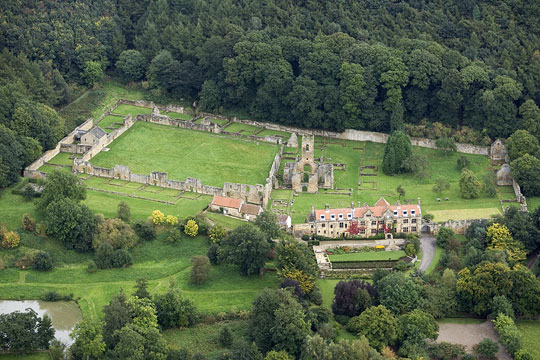Significance of Mount Grace Priory
Mount Grace is the best-preserved and most accessible of the Carthusian monasteries (charterhouses) in England, and the fifth of only six established in England after the Black Death of 1348–9. The last monastery founded in medieval Yorkshire, it was also one of the last in the county to be suppressed. Because of its exceptional state of preservation it has been unusually well studied.

Carthusian Monastery
Carthusian monasteries account for only a small proportion of English religious houses, a little over 1%, and are less well known than those of other orders. They are very different in their planning and scale from other monasteries, and their survival as standing ruins is poor.
Yet the Carthusians were a significant order, particularly in the later Middle Ages. Mount Grace was selected as the best example of a Carthusian monastery by Sir William St John Hope in the 1890s in his typological study of houses of the major religious orders,[1] simply because of the exceptional survival of its buildings.
Despite a recent research programme on Carthusian monasteries conducted by the University of Bristol, the then Royal Commission on Historical Monuments for England (now part of English Heritage) and English Heritage that looked at all English charterhouses, Mount Grace remains pre-eminent.[2]
Extent of Study
Mount Grace has been the subject of modern archaeological study on a scale rarely achieved at a house of any religious order, with some 35% of the central buildings excavated and all the surviving fabric analysed.[3]
Only three other Carthusian monasteries in Europe, Nieuwlicht at Utrecht,[4] St Bartholomew at Delft,[5] and Our Lady of Bethlehem at Roermond,[6] all in the Netherlands, have been studied on a comparable scale. All lack the substantial survival of buildings that distinguishes Mount Grace.
The site is seen across Europe as a type-site (model) for the study of late medieval Carthusian houses.
International Significance
Mount Grace Priory is a site of international significance because:
- it is one of the best-preserved medieval charterhouses to survive anywhere in Europe, with no serious post-medieval alteration
- it has been the subject of high-quality archaeological and architectural study since the late 19th century, and particularly in the late 20th century
- its archaeological and architectural collections are extensive, well provenanced and extensively researched
- it has been studied in the context of all English charterhouses and its place in their development determined.
National Significance
Mount Grace is also of national significance because:
- it is the only publicly accessible Carthusian monastery in England
- its monastic ruins were among the first to be conserved using the principles of the Society for the Protection of Ancient Buildings
- it is directly comparable with equally significant monastic ruins of other orders in Yorkshire
- it has an important surviving post-Suppression house that is directly related to the ruined elements of the site
- Sir Lowthian Bell’s restoration and extension of the house in the first years of the 20th century is a significant example of Arts and Crafts building true to the principles of John Ruskin and William Morris[7]
- Mount Grace has produced the largest sample of food waste from 15th-century England from firmly stratified deposits in the monks’ kitchen, providing exceptional evidence for the monastic diet and its development, together with evidence from individual excavated cells, not seen anywhere else in England.[8]
READ MORE ABOUT MOUNT GRACE PRIORY
Footnotes
1. WH St John Hope, ‘Architectural history of Mount Grace charterhouse’, Yorkshire Archaeological Journal, 18 (1905), 270–309 (accessed 10 April 2014).
2. For a summary of this unpublished survey see G Coppack and M Aston, Christ’s Poor Men: The Carthusians in England (Stroud, 2002).
3. G Coppack and LJ Keen, Mount Grace Priory: The Excavations of 1957–92 (London, forthcoming).
4. T Hoogendijk, ‘Kartuizerklooster Nieuwlicht: de archeologie van een Utrechts klooster’ (unpublished report, Zaandijk, 2012); CMW den Hartog, ‘Nieuw Licht op de Marnixlaan: een archeologisch onderzoek naar het kartuizerklooster Nieuwlicht’, Basisrapportage Archeologie 66 (unpublished report, Utrecht, 2013).
5. HH Vos, ‘Archeologisch onderzoek naar het voormalig Kartuizer Klooster buiten Delft’, in De Kartuizers en hun Delftse klooster: Een bundel studiën verschenen ter gelegenheid van het achtste lustrum van het Genootschap Delfia Batavorum, ed R Rothfusz et al (Delft, 1975), 17–36.
6. JEM Wattenberghe, JE van den Bosch and BAJT Dukers, ‘Archeologische Opgraving Bethlehemstraat-Voogdijstraat, Roermond’ (unpublished report, SOB Research, Heinenoord, 2011).
7. A Morrison, ‘Mount Grace Priory: the rediscovered historic interiors of the manor house’, Collections Review, 4 (English Heritage, London, 2003), 125–8.
8. S Bailey et al, ‘Assessment of biological remains from excavations at Mount Grace Priory, North Yorkshire’, Environmental Archaeology Unit, York, Report 94/10 (1994); B Irving and AKG Jones, ‘Technical report: fish remains from Mount Grace Priory, N Yorkshire’, Environmental Archaeology Unit, York, Report 94/54 (1994).